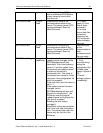
Klinkmann Automation Omron Ethernet DAServer 44
Omron Ethernet DAServer Ver 1.x User Manual Rev 1.3 17014m13
102 - IR Output area (Word contents), word address 102
LR62.10 - LR area (Bit status), word address 62, bit number 10
DM21 - DM area (Word contents), word address 21
DAServer Standard System Items
System Items provide you with easy access to the DAServer status and diagnostics
information. They are treated just like ordinary items with respect to the client. However,
in most cases these items are not directly acquired via the communications layer. System
item values are usually generated through internal calculations, measurements, and the
tracking of the DAS Engine.
No DAServer-specific system items are provided in this Omron Ethernet DAServer.
System items, like ordinary items, are defined by the following properties:
• Group (client group/OPC group): The arbitrary collection of items, not correlated.
• Hierarchical location (link name/OPC path. The hierarchical node section of the fully
qualified OPC item ID.): The device the item is attached to.
• Device group (OPC access path/topic, or a Scan Group on a hierarchical branch.): A
collection of items on the same physical location with the same protocol update rate.
Example:
To check the status of an external device, the reference might be:
DASOmronEth.Socket1.$SYS$Status
Note: This syntax does not refer to the access path/device group. As long as the data
requested is from the same external device, the value will always be the same.
Note: For DDE/SuiteLink clients, $SYS$Status always comes from the leaf level of a
DAServer hierarchy branch, which is the destination PLC node. For OPC clients,
$SYS$Status can be accessed at all hierarchy levels. $SYS$Status at the root level of
the whole hierarchy tree is always good, as it represents the quality status of the local
computer itself. Hence, for practical application, OPC clients should reference
$SYS$Status at any hierarchy levels other than the root.
In the ArchestrA context, the device group plays the most important role of identifying the
scope of any item (the device group defines the hierarchical location implicitly when using
globally unique device-group names, which is required for DDE/SuiteLink compatibility).
All system items follow the same naming convention:
• All system items start with $SYS$.
• The DAS Engine scans and parses the name for system items.
• Parsing of the name is case-insensitive.
All system items can be accessed through subscriptions to a device group. However,
while some system items return data for that device group, others are server-wide.


















